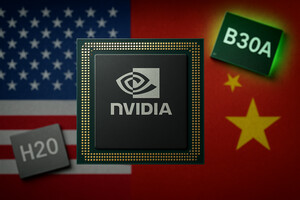Nvidia Developing New China AI Chip That Outperforms the H20
Nvidia is developing a new AI chip for the Chinese market based on its latest Blackwell architecture that will be more powerful than the H20 model it is currently permitted to sell there, two people f

Nvidia is developing a new AI chip for the Chinese market based on its latest Blackwell architecture that will be more powerful than the H20 model it is currently permitted to sell there, two people familiar with the matter told Reuters.
The new chip, temporarily named B30A, will use a single-die design likely to deliver about half the raw computing power of the dual-die configuration in Nvidia’s flagship B300 accelerator, the sources said. A single-die design means all core components of an integrated circuit are built on one continuous piece of silicon rather than split across multiple dies.
The chip will also feature high-bandwidth memory and Nvidia’s NVLink interconnect technology for fast data transmission between processors — the same features found in the H20.
Specifications have not yet been finalized, but the sources said Nvidia hopes to deliver samples to Chinese customers as early as next month for testing.
Separately, two other sources said Nvidia is preparing to ship another new Blackwell-based chip for the Chinese market, the RTX6000D, designed mainly for AI inference tasks. Its performance will be weaker than the H20, and its price lower, reflecting the reduced specifications.
The RTX6000D is designed to fall under thresholds set by the U.S. government. It uses conventional GDDR memory with bandwidth of 1,398 gigabytes per second, just below the 1.4 terabyte-per-second limit set by restrictions introduced in April that triggered the initial H20 ban.
Nvidia will deliver small quantities of RTX6000D to Chinese customers in September.
H20 Faces Backlash in China, Can Nvidia Break Through With New Chips?
In the last fiscal year, China accounted for 13% of Nvidia’s revenue, making the market too significant for CEO Jensen Huang to abandon. Launching a chip that outperforms the H20 may be key to regaining share in China.
Amid deteriorating U.S.-China relations, Chinese regulators in recent weeks have issued directives to both state-owned and private companies requiring them to adopt domestic alternatives instead of Nvidia’s H20 for any projects tied to national security.
Chinese state broadcaster CCTV’s affiliated media outlets also criticized the H20. A commentary concluded: “When a chip is neither green, nor advanced, nor secure, consumers naturally can choose not to buy it.”
Meanwhile, Reuters reported that the U.S. government has identified a batch of high-end chips at high risk of being smuggled into China and secretly embedded tracking devices in them, reinforcing Beijing’s national security concerns.
Analysts at Bernstein estimate that, based on Nvidia’s previous guidance, the company was expected to sell around 1.5 million H20 chips to China in 2025, generating about $23 billion in revenue. With Beijing’s strong opposition, Nvidia may now need to significantly revise its forecast.
Disclaimer: The views in this article are from the original Creator and do not represent the views or position of Hawk Insight. The content of the article is for reference, communication and learning only, and does not constitute investment advice. If it involves copyright issues, please contact us for deletion.